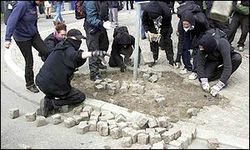Tadzio Mueller: What’s Really Under Those Cobblestones? Riots as Political Tools, and the Case of Gothenburg 2001

Prelude: Våldsromantik
Riot – the unbeatable high! Adrenaline shoots your nerves to the sky. (The Dead Kennedys)
There’s a great word in Swedish, one of those compound nouns of which the English language sadly is not capable: Våldsromantiker.1 Someone who is captured by the romanticism of violent struggle, by the exhiliration, fear, adrenaline, and existential positioning of physical confrontation. Predictably, most våldsromantiker tend to be men. So now, here it is: I, too, occasionally suffer from våldsromantik. Ever since getting involved in ‘radical’ activism I have relished most these moments when the boundaries of legality are crossed, where there is rapid movement, and where there is at least a potential for physical escalation. What a confession. Unsurprising – våldsromantik seems to be common among alienated middle class young men like myself – and politically unpleasantly incorrect. Mind you, not that I was ever much of a street fighter. I generally just hover around the edges of confrontations, tickled by fear and adrenaline, a spectator in a spectacle of violence, ‘dissent’, and oppression. But I did not write this text to confess my personal/political weaknesses. Rather, I write it to offer a (qualified) defense of them, not by extolling the virtues of ‘rioting’, or ‘violent protest’ in general, but by attempting to point out what I take to be the positive impacts (from a left-libertarian perspective) that one particular riotous event had, namely the riots that occurred during the protests against the European Union (EU) summit in Gothenburg, Sweden, in the summer of 2001, one month before the fateful events of Genoa.
Download full text at www.ephemeraweb.org
Source: www.ephemeraweb.org



